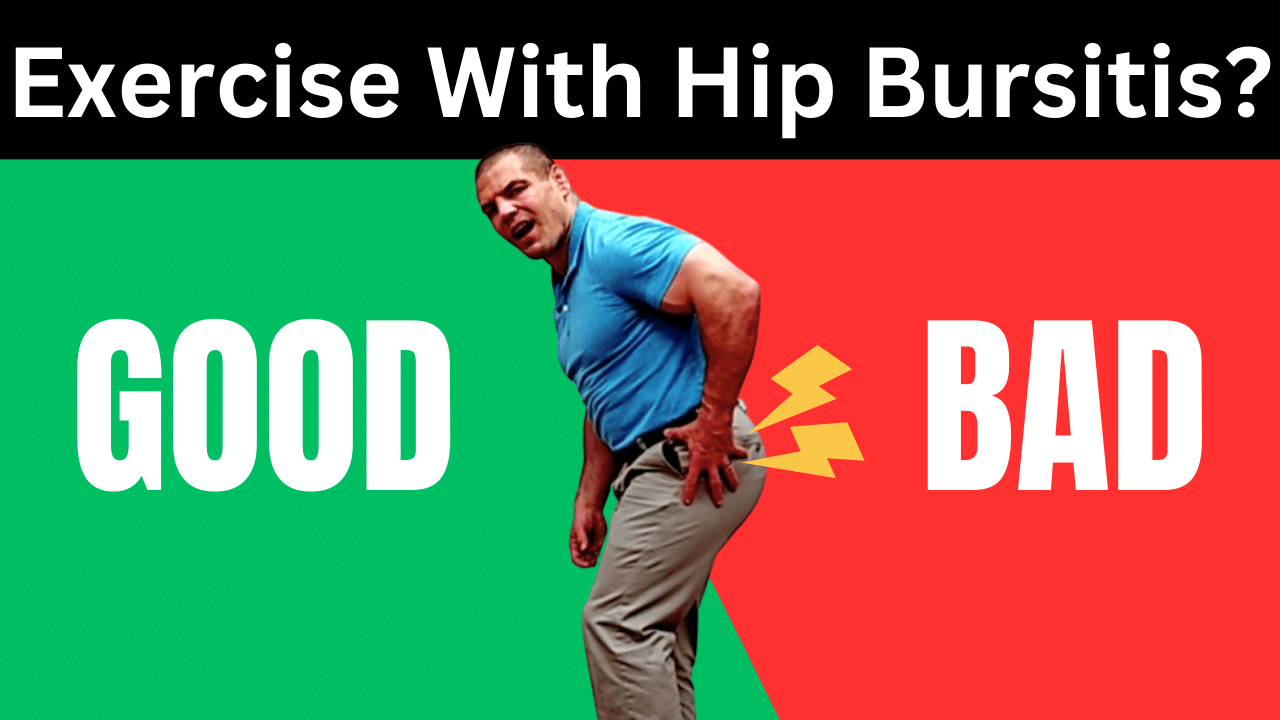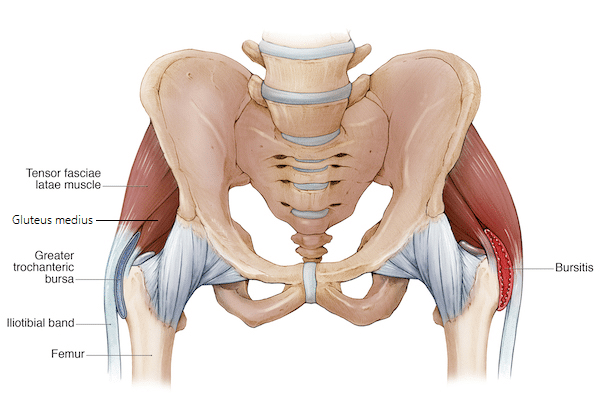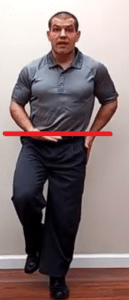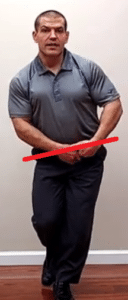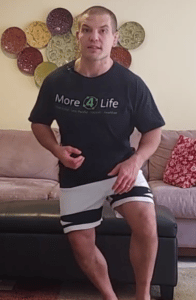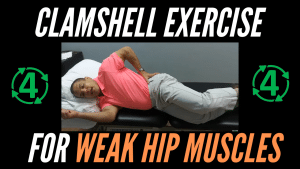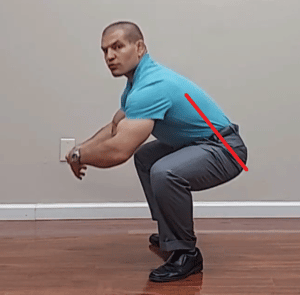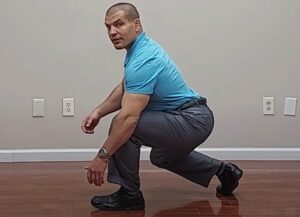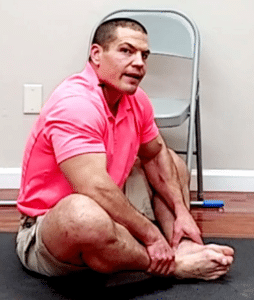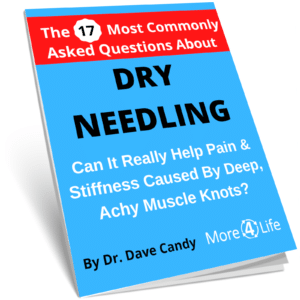If you have hip bursitis, you may wonder if it's okay to push through the pain and keep exercising with hip bursitis, or whether you need to stop and rest. The short answer is:
You CAN keep exercising with hip bursitis.
In fact, you should keep exercising if you have hip bursitis.
Watch the video to learn which exercises are okay to do, which exercises you should avoid, and what exercises can help you recover from hip bursitis so you can get back to walking, running, climbing stairs, and other activities that you enjoy.
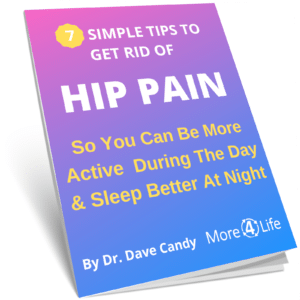
In this post, you'll learn:
- What Is Hip Bursitis?
- What Causes Hip Bursitis?
- Which Exercises Are Okay and Which Exercises Should You Avoid with Hip Bursitis?
- Running With Hip Bursitis
- Walking With Hip Bursitis
- Strengthening Exercises for Hip Bursitis
- Stretching Exercises for Hip Bursitis
- Other Kinds of Treatment for Hip Bursitis
- Need Treatment For Hip Bursitis?
What Is Hip Bursitis?
What exactly is hip bursitis?
"-itis" means "inflammation of", and a bursa is a fluid-filled sac.
So bursitis means inflammation of that fluid-filled sac.
Your hip bursa sits right over the widest part of your hip called the greater trochanter. That's why hip bursitis is sometimes referred to as trochanteric bursitis.
As you can see, your hip joint is actually in the groin.
It's NOT on outer side of the hip where people experience pain when exercising with hip bursitis.
So, hip bursitis is more of a soft tissue type of injury.
Furthermore, it's not always the bursa that's inflamed.
A true bursitis is the inflammation of that bursa as seen on the right side of the picture.
However, if you got a diagnosis of "hip bursitis" from your doctor, there are several things that can cause similar symptoms.
- inflammation of the trochanteric bursa
- the gluteus medius and gluteus minimus tendons
- the IT band
If you have pain on the outside of the hip, it doesn't really matter whether it's bursitis or tendonitis or IT band syndrome.
In reality, it's probably a combination of two or three of those.
But it really doesn't matter because the mechanism by which those structures get inflamed or irritated or injured is the same.
What Causes Hip Bursitis?
Hip bursitis is caused by repetitive strain.
When you're walking or running, if your hip bone goes too far out to the side, it can bump into the bursa, IT band, or gluteal tendons.
That in turn can cause hip bursitis or forms of outer hip pain. Once the pain starts, it may hurt when lying on your side at night as well as when you're active during the day.
Usually running is the exercise most likely to aggravate hip bursitis pain. However, walking or other types of repetitive aerobic activity can cause hip bursitis as well.
Which Exercises Are Okay and Which Exercises Should You Avoid With Hip Bursitis?
The simple answer to that is:
Exercises that don't bother you are okay to do.
You should avoid exercises that cause hip bursitis pain during or after exercising.
It is a good idea to keep exercising with hip bursitis because that keeps your joints lubricated and it keeps your muscles conditioned. If you lose strength in your muscles, that makes you more likely to develop problems in the future. That may be in your hip, or in your lower back, knee, or foot.
Running With Hip Bursitis
Runner's HATE not being able to run. (But if you're a runner, you already know that.)
So you CAN keep running with hip bursitis, but with some limitations.
If you only develop hip bursitis pain, say, five miles into your run, but you're okay for the first two or three miles, well then stop after mile or two.
Stop right BEFORE you start to have symptoms.
If it's later in your run that you start to develop symptoms, then it's not necessarily a problem of muscle stiffness or muscle weakness.
It's a problem of endurance.
That your muscles are strong enough to keep your body balanced over your hip as you're running for the first few miles, but then they tire out.
So if you back off a little bit and run a distance that you're able to run comfortably, your muscles will build up their endurance over time, and you can gradually start to increase increase your running volume until you get back to that 5 or 10 miles (or 13.1 or 26.2 miles) that you want to be able to run.
Pushing through hip pain when running is a bad idea.
Back off your training distance until you have no symptoms and then start gradually building back up.
The typical rule of thumb is only to increase your running distance by about 10% per week.
If you're starting at like 0.1 or 0.5 miles, obviously you can increase a little bit faster than that - maybe a quarter to a half a mile per week.
Now if you're up at 5 or 10 miles, then that 10% rule holds pretty true.
But again, you should not push through hip pain when running if you have hip bursitis because you're just inflaming the problem more and making it last longer.
Walking With Hip Bursitis
You can still get hip bursitis when exercising ever if you're not a runner. Walkers can get hip bursitis as well.
Just like with running, if you have hip bursitis with walking a mile, then start with half a mile and build up your endurance.
But if you get hip bursitis pain on your very first step after standing up from a chair, and the pain keeps getting worse the longer you walk, there likely IS a strength problem in your hips.
Alternative Aerobic Exercise For Hip Bursitis
In this case, its a good idea to do non-weight-bearing aerobic exercises, such as using a seated elliptical or using an exercise bike.
You might also consider using a hybrid recumbent bike / ellipitcal so that when your hip starts to feel better, you can stand up and use the elliptical.
If you can't even take a few steps without pain, it's probably also a good idea to walk with some crutches or a cane, something to offload your hip.
A lot of people don't like walking with a cane because they think it makes them look old.
However, it's not forever. You just want to use it long enough that you allow your hip muscles to recover.
Let's say you're lifting a barbell, and let's say you're strong enough to lift 50 pounds over your head.
What would happen if someone gives you a 100-pound weight?
Well, you're not going to be successful if you keep trying to lift that 100-pound weight.
So using crutches or a cane allows you to take away some of the weight. (Your bodyweight in this case.)
Remember above I mentioned that when you have an endurance problem you back down the distance or duration?
Well, if you have a strength problem, then you back down the weight.
But then you gradually progress back to walking with full bodyweight as you get strong enough to walk pain-free.
So what exercises can you use to get your hip muscles stronger?
Strengthening Exercises for Hip Bursitis
Usually with hip bursitis, the muscles that need to be strengthened are the gluteus medius and the gluteus minimus.
These two muscles help balance your pelvis over your leg.
You tensor fascia latae muscle often helps with it that as well, but usually tensor fascia latae is OVER-activated, which leads to your IT band getting tight.
Usually though, it's BECAUSE the gluteus medius and gluteus minimus muscles are weak level that the tensor fascia latae ends up working too hard to take up the slack.
Since your outer hip muscles do the job of balancing your pelvis during activity, that's a great exercise to start with if you have hip bursitis.
Balance Exercise For Hip Bursitis
If you can't even hold your pelvis level, your chances of being able to walk and certainly being able to run without hip pain aren't very good.
So start by standing on one leg trying to keep your pelvis level.
You DON'T want to allow your pelvis to drop.
If your pelvis drops as soon as you lift your leg, you can start with a toe on the ground and just balance like that.
As you get stronger and you're able to keep balanced with your toe on the ground, progressively take weight off of the toe until you're still able to keep balanced without your toe touching the ground.
Single Leg Mini-Squat Exercise
Once you can balance on one leg, you next need to be able to control your pelvis when bending your knee such as while climbing stairs or landing on one leg while running.
So the next step from just being able to balance on one leg is doing a little squat on one leg.
You can do this on the bottom step of a staircase, like a step-up or step-down.
Keep your pelvis level as you're bending from the hip and knee with your weight on your heel.
Keeping your weight on your heel will strengthen your hip muscles more. If your weight is on your toe, the exercise becomes more of a quadriceps (thigh) strengthening exercise.
This exercise also helps work on your balance and your motor control at the same time as you're strengthening your hip.
If you're not a runner, and you just want to be able to do your everyday activities such as walk and go up and down stairs without pain, chances are those two exercises may be enough.
However, if you want to be able to run, you need to be able to land on one leg.
Single Leg Hop Exercise
You can practice landing on one leg by doing sequential single-leg hops.
Take a short hop and then stick your landing without doing a double hop.
Once you can control your landing on a small hop, then gradually take bigger hops so that you are able to land on one leg and still control your pelvis.
Once you can do that successfully, you're probably strong enough to start running.
From there, it's just a matter of building up your distance and your muscle endurance as mentioned above.
Other Strengthening Exercises For Hip Bursitis
Clamshell Exercise
What about other exercises like clamshells?
Well, those are pretty low-level hip strengthening exercises. If you're having trouble just walking or bearing weight, then you may want to start with clamshells. Or if you have hip arthritis or you've had a hip replacement, you may also need to do clamshells to start out with.
Keep in mind if you do them, that most people do clamshells WRONG. Here's how to do clamshells correctly.
If you're someone who regularly exercises though, clamshells may be a little bit too low-level of an exercise for you.
Squats
Squat are good for strengthening your glutes, but those are mostly good for your gluteus maximus (butt muscles).
Because you're balanced on two legs, you don't get much side-to-side strengthening. So a better exercise would actually be doing a lunge.
Lunges For Hip Bursitis
To do a lunge to help hip bursitis, take a step forward with one leg.
Keep your weight on your heel, and knee over your toes.
The advantages of lunges for hip bursitis are that you still have to control the side-to-side movement of your leg, but you're also able to go deeper than you might with a single-leg squat.
So those are strengthening exercises for hip bursitis. Now what about stretching exercises?
Stretching Exercises for Hip Bursitis
If you have pain on the outside of your hip, should you do stretching exercises?
There may be some stretches that are helpful for you, but the one stretch you probably want to AVOID is doing an "IT band stretch" where you cross your legs and push one hip out to the side.
A lot of people think that when you have something that's painful, that it's a good idea to stretch it.
But in this case, the overstretching of the muscles on the outside of the hip is what caused the problem in the first place. So stretching further into hip adduction is NOT a good thing to do if you have hip bursitis.
Now, there may be some other areas that are stiff.
For example, often if you're overstretched on the outer hip muscles, then your groin muscles or inner thigh muscles may be stiff.
So doing a sideways lunge to stretch your inner thigh muscles may help stretch your groin muscles. Or you can do a butterfly stretch where you sit on the floor and push your knees out to the side.
So those were my tips on how to keep exercising with hip bursitis. But exercises aren't the only treatment for hip bursitis.
Other Kinds of Treatment for Hip Bursitis
So what other treatments, besides exercise, are good if you have hip bursitis?
Corticosteroid Injections For Hip Bursitis
Well, one of the really common treatments that people get is a corticosteroid injection or a cortisone injection in their hip.
For some people, those work really well. Sometimes that knocks out the pain really, really quickly. And if that's the case for you, that's wonderful.
There are a few things that you should know, though.
Cortisone or other types of coritcosteroids weaken tendons. So although it's okay to have one, you don't want to have them repeatedly.
The other thing you should know about cortisone injections is that although they're really strong anti-inflammatories, they don't necessarily fix the problem that caused that inflammation to come on in the first place.
So even if you need a cortisone injection to get over the pain quickly, you still want to get the muscles stronger so you don't re-inflame your bursa or IT band or gluteal tendons that run over the outside of the hip.
Because if you have to keep having cortisone injections, that's bad news.
Dry Needling For Hip Bursitis
If you're someone who doesn't want to rely on medications or have steroid injections in your hip, there's another treatment that works really well for hip bursitis and other types of lateral hip pain.
It's called dry needling.
Dry needling is is essentially taking an acupuncture-type needle and putting it in the muscles around the hip.
Research has shown that there's a strong "needle effect" to injections. Whether you have a medication in the needle or whether you're just poking the needle in the muscles, when you hit a knot or a trigger point, there's actually a mechanical effect. When the needle hits the trigger point and releases it, that often can relieve hip pain really, really quickly, even if there's nothing in the needle.
The other nice thing about dry needling is that there's no medication, and therefore the needle is much smaller because you don't have to shoot something through the needle. Plus, you don't risk the negative side effects of corticosteroids.
Need Treatment For Hip Bursitis?
If you need help for hip bursitis, we'd be happy to help you. We'll help you figure out what caused your hip bursitis, plus what exercises and other treatments can help resolve it as quickly as possible so that you can get back to being active again.
Just tap the button below to request an appointment with one of our specialists.

